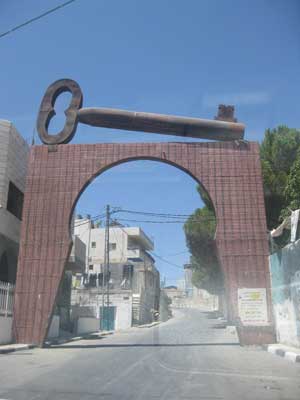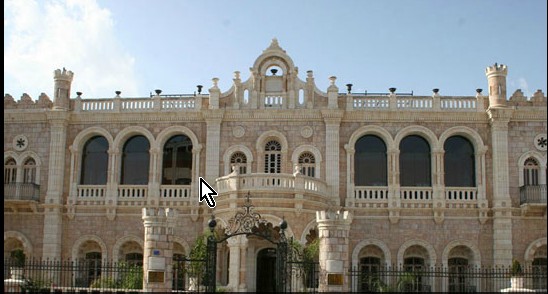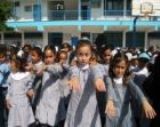http://www.winnipegjewishreview.com/article_detail.cfm?
id=1487&sec=3&title=Teaching _
Introduction
The essence of the Middle East conflict is the century-long struggle between Jews and Palestinian Arabs over one piece of land stretching between the Mediterranean and the River Jordan, which both parties regard as their historic homeland. The United Nations Organization’s attempt in 1947 to solve the conflict by way of partition was rejected by the Arab side, which opened a war against the Jews in December that year. The war between the Jews and the Palestinian Arabs, to which five Arab armies joined in May 1948, lasted for sixteen months and ended in an Arab defeat. Both Jews and Palestinians lost in the war one percent of their respective populations. One of the results of that war was a mass exodus of Palestinians from areas taken over by the Jews, which later became part of the nascent State of Israel. In subsequent years, a parallel number of Jews came to Israel from the neighboring Arab countries, partly as a result of the deterioration of their conditions there following the war.

Entrance to Aida Palestinian Refugee Camp near Bethlehem where refugees are educated at UNWRA schools.
The key representing the right of return that says “not for Sale”
photo by Rhonda Spivak
The Palestinian and Arab narrative of the Middle East conflict emphasizes what is termed “the Right of Return” which is interpreted as the personal right of every Palestinian, who left his or her home in Palestine in 1948 or afterwards, to return to it and to reclaim his or her property in full. This perceived right also applies to the refugee’s descendants with no limit of number, time or place of birth.[1] Thus, the total number of such claimers has grown during the period that has passed since 1948 from few hundred thousands to several millions. Although said to have legally been based on the Universal Declaration of Human Rights and on Resolution No. 194 adopted by the UN General Assembly on Dec. 11, 1948,[2] it is clear that such a claimed right has no legal precedence in history and, indeed, has not been applied in other cases of wartime refugees throughout the twentieth century, which witnessed a record number of such refugees.
Apart from its unique character in international terms, the “Right of Return” also raises serious political and human problems, since its full application would mean the destruction of the State of Israel as a Jewish state and thus deny the Jewish nation its right to self-determination, which has been legally recognized by virtue of the UN partition resolution. Indeed, throughout the years that succeeded the establishment of Israel, the “Right of Return” issue was often mentioned in Arab forums within the wider context of the discussion of Israel’s liquidation. In Israeli eyes, therefore, the continued persistence on the “Right of Return” by any Arab party betrays that party’s desire to wipe Israel off the map. Any impartial observer must admit that such fears are solidly grounded in light of the human mass involved.

InterContinental Hotel in BETHLEHEM (JACIR PALACE).
The new wing overlooks the Deheishe Refugee camp. Located: Jerusalem-Hebron Road, Bethlehem, Palestinian Authority
If peace in the region is meant to be concluded between the Jewish State and its Arab neighbors – and it is so meant internationally – then the “Right of Return” issue should not stand in the way to peace as it does today. That is especially important in school, in particular – schools that are run by an international body such as UNRWA, which is bound by UN resolutions regarding peace in the region and is expressly committed to the ideal of peace.[3]
This paper will try to find out whether UNRWA does follow its commitment as far as teaching of the “Right of Return” is concerned. At this point the discussion will be limited to UNRWA’s schools in the West Bank, the Gaza Strip and East Jerusalem. In later phases this research will include as well UNRWA’s schools in Syria, Lebanon and Jordan.
UNRWA’s Educational System
UNRWA – the United Nations Relief and Works Agency for the Palestinian refugees in the Middle East – was established in the wake of the Arab-Israeli war of 1948 by the UN General Assembly resolution 302 (IV) of December 8, 1948, in order to carry out relief and works programs for the Palestinian war refugees. The Agency began operations on May 1, 1950. In the absence of a solution to the refugee problem, the Assembly has repeatedly renewed UNRWA’s mandate.[4]

Sutdents at Aida Refugee Camp
Over half of UNRWA’s general budget is dedicated to education (52% of a total of US$1.2 billion in 2009).[5] The Agency also offers health, relief and social services. UNRWA provides free-of-charge basic education to children of Palestinian refugees in the Palestinian Authority-controlled West Bank, the Hamas-controlled Gaza Strip, the Israel-controlled East Jerusalem, and in Jordan, Syria and Lebanon. In the academic year of 2009/2010 it ran a total of 691 schools caring for 483,000 students. 228 of these schools were in the Gaza Strip and 97 were in the West Bank, with 206,000 and 56,000 students, respectively.[6] Two of UNRWA’s West Bank schools are actually located in the greater Jerusalem area which was annexed to Israel in 1967.
Basic education means both elementary and intermediate (also called “preparatory”) schools, that is, grade 1-9 or 10, depending on the specific school system in each country. Only in Lebanon does the Agency operate some nine high schools as well, since Palestinian students of these grades find it difficult to study in local public or private schools.[7]
The Agency maintains close cooperation with government educational authorities in its various areas of operation. Students at UNRWA schools study the same curriculum and use the same books authorized by the host governments (except for East Jerusalem where the PA curriculum and books have been adopted for use instead of the Israeli ones).
Beside the schoolbooks issued by the respective national authorities with no involvement on UNRWA’s part, the Agency has published several textbooks of its own which teach issues such as tolerance and human rights in its schools, as it testifies: “One of our key progammes promotes human rights and non-violent communication skills, conflict resolution and tolerance.”[8] However, these additional books do not usually touch sensitive issues related to the conflict such as the attitude to the “other” or the possibility of solving the conflict peacefully.
The source material for this paper has been some 150 textbooks of the various subjects taught in grades 1-10 at UNRWA’s schools under the PA-created curriculum. Many of them appear on the PA Ministry of Education’s Web site, and the others, including later editions and reprints of the original books, have been purchased.
Teaching “The Right of Return” I: The Ideological Foundations
The “Right of Return” is based ideologically on the argument that Palestine belongs to the Palestinian Arabs alone and that it became the focus of Jewish Zionist greedy ambitions [atma’] in the nineteenth century with a view to expelling or exterminating the indigenous population. Those ambitions were supported by British Imperialism in the twentieth century and culminated at the UN Partition Resolution of 1947. Then, war broke out in which the Arab side was defeated and Zionist terrorist organizations expelled a whole nation from its homeland and established the State of Israel.
Quotations
“The Zionist colonialist greedy ambitions in Palestine started in 1882…
The coming of the Jewish throngs to Palestine continued until 1948 and their goal was taking over the Palestinian lands and then taking the original inhabitants’ place after their expulsion or extermination…
The Zionist greedy ambitions increased with the support of British Imperialism, as the British foreign minister Lord Balfour issued his declaration on November 2, 1917 which called for giving the Jews a national home in Palestine…
The Zionist terrorist organizations forced thousands of Palestinians to leave their country under the threat of arms, which brought about the emergence of the refugee problem.”
(National Education, Grade 7 (2011) pp. 20-21)
“Israeli Occupation
Palestinian society underwent the Catastrophe [Nakbah] in 1948 [inflicted] by the Zionist organizations, when the majority of the Palestinians were made to emigrate from their land and the State of Israel was established in part of Palestine.”
(National Education, Grade 5 (2009) p. 30)
“In the year 1947 the United Nations Organization adopted a resolution partitioning Palestine between the Arabs and the Jews. Accordingly, the British Mandate over Palestine ended and the Mandate government withdrew. Then, war erupted between the Arabs and the Jews in 1948, which brought about the capture of part of Palestine by the Jews and the occurrence of the Catastrophe [Nakbah] which caused most of the Palestinians to emigrate.”
(Reading and Texts, Grade 8, Part 1 (2009) p. 67)
Under such circumstances (this line of argumentation continues) it would be only natural that those refugees (and their descendants) will be entitled to return to their usurped homeland by all means any time. In fact, the textbooks used in UNRWA’s schools never discuss any other possible solution to the Palestinian refugee problem.
Quotations
“The number of the Palestinians in the world is close to nine millions… Four and a half millions live in the Diaspora outside of Palestine… Most of them are refugees who wait to return to the motherland after having been expelled from it…”
(National Education, Grade 4, Part 1 (2011) p. 43)
“The [refugee] camp is not considered an original home for the Palestinian refugee. Rather, it is a temporary place where he has been forced to live. All the Palestinians wait for the return of every Palestinian to his city or village from which he was made to emigrate.”
(Islamic Education, Grade 6, Part 1 (2011) p. 69
Teaching “The Right of Return” II: Practice
The “Right of Return” is part and parcel of the discussion of the conflict. It appears in poems and stories, such as the one in which a father is showing to his son the ownership deeds of the land they owned in the coastal plain and “the keys of our house which we were forced to leave by the [Israeli 1948] occupation”, and the son promises to keep it.[9] Besides, there are language exercises using this theme such as the following one:
“Activity 2: Let us fill in the empty space with the appropriate noun…
The…[refugee]… dreams of returning to his homeland.”
(Our Beautiful Language, Grade 5, Part 1 (2011) p. 91)
Another assignment is an expression exercise:
“Expression:…I visited the city of Jaffa [which is within Israel’s borders since 1948] and while I was [strolling] along its streets and neighborhoods I saw an Arab-style house that was empty of its dwellers. I imagined it telling me its story, and it said:… [to be completed by the student].”
(Reading and Texts, Grade 9, Part 1 (2011) p. 120)
In anart lesson in which the student is requested to draw his or her house the teacher is given a suggestion related to this issue:
“It is possible to make a connection between the house in the refugee camp and the houses left by their [i.e., the students’] parents and grandparents in the Palestinian cities and villages in 1948.”
(Arts and Crafts, Grade 2 – Teacher’s Guide (2001) p. 44)
Especially interesting in this context is the use of poems in order to strengthen among the students the sense that the return is inevitable. The poems add an emotional dimension to the issue and reveal one of its characteristics that is not usually evident in other forms of discussion of the “Right of Return”.
The Violent Character of “The Right of Return”
The “Right of Return”, by definition, is a right, not a privilege. As such, it does not depend on Israel’s good will and is not part of the peace process. Rather, it is presented as a decisive event, shrouded in an atmosphere of violence. The following two poems well exemplify that:
“We Shall Return
…
Tomorrow we shall come back and the ages shall listen
To the footfalls during the return
We shall return with the resounding storms
With the sacred lightening and the star
With the winged hopes and the songs
With the soaring vulture and the eagle
Yes! The thousands victims shall return
Victims of oppression shall open every door”
(Our Beautiful Language, Grade 7, Part 1 (2002) p. 34)
“We Shall Return
Return, return, we shall return
Borders shall not exist, nor citadels and fortresses
Cry out, O those who have left:
We shall return!
[We] shall return to the homes, to the valleys, to the mountains
Under the flag of glory, Jihad and struggle
With blood, sacrifice [fida’], fraternity and loyalty
We shall return
[We] shall return, O hills; [we] shall return, O heights
[We] shall return to childhood; [we] shall return to youth
To Jihad in the hills; [to] harvest in the land”
(Our Beautiful Language, Grade 5, Part 1 (2011) p. 50)
The terms Jihad, struggle and blood imply that the implementation of the “Right of Return” does not stand alone but rather comes within the wider context of the liberation struggle against Israel, which necessitates a few references to this latter issue.
The Struggle against Israel
To begin with, Israel is not a legitimate state according to the PA achoolbooks studied in UNRWA’s schools. The name “Israel” does not appear on the map, the term “Israeli territory” is replaced by circumlocutions such as “the Lands of 1948”, Israel pre-1967 regions and cities are presented as Palestinian, etc.
Quotations
“Map No. 12: The Coastal Plains of the Levant”
“Palestine”
(Geography of the Arab Homeland, Grade 9 (2005) p. 28)
“The land of the Levant [Al-Sham in Arabic] presently comprises the following states:
1. Palestine
2. The Hashemite Kingdom of Jordan
3. The Republic of Lebanon
4. The Syrian Arab Republic
(History of the Ancient Civilizations, Grade 5 (2004) p. 30)
“Haifa and Gaza are two Palestinian…[ports]…”
(Our Beautiful Language, Grade 5, Part 2 (2005) p. 86)
“Activity: Let us color the Negev desert on the map of Palestine.”
(National Education, Grade 2, Part 1 (2001) p. 25)
The Jewish presence in the country in the past and at present is also denied: There are no Jewish rights in Palestine – only “greedy ambitions”, no Jewish holy places (the Wailing Wall in Jerusalem, the Cave of the Patriarchs in Hebron and Rachel’s Tomb in Bethlehem are all considered Muslim holy places usurped by Jews), Israel’s 5.5 million Jews are not counted among the country’s legitimate inhabitants while Israeli Arabs and Diaspora Palestinians are, Jewish cities – including Tel Aviv – are not shown on the map, etc.
Israel, then, is not presented as an ordinary sovereign state, but rather as an occupying entity existing at the expense of the Palestinian people’s right to self-determination in its own homeland. In addition, Israel is presented as a source of many evils directed against the Palestinians and other Arabs (during my ten-year research of PA achoolbooks I have gathered over thirty accusations against Israel in various fields).
Accordingly, no peaceful solution to the conflict is advocated in the PA books used in UNRWA’s schools. Instead, a violent struggle of liberation against its occupation (both before and after 1967) is promoted. This struggle, which is never said to be restricted to the areas of the West Bank and the Gaza Strip, is made more compelling by the use of the traditional Islamic concepts of Jihad and martyrdom [shahadah] within its framework. Examples:
“Good morning, O my homeland…
A morning of glory and liberty, watered by the martyrs’ blood…
[Assignment:] I will reconcile the following poetic lines with the feelings they express:
‘A morning of glory and liberty, watered by the martyrs’ blood…’ – the hope for the liberation of Palestine.”
(Reading and Texts, Grade 9, Part 1 (2011) pp. 20-21, 24)
“Palestine
O brother, the oppressors have exceeded all bounds and Jihad and sacrifice [fida’] are imperative…”
(Reading and Texts, Grade 8, Part 1 (2009) p. 66)
“The Martyr
…
Hearing [weapons’] clash is pleasant to my ear
And the flow of blood gladdens my soul
As well as a body thrown upon the ground
Skirmished over by the desert predators
…
By your life! This is the death of men
And whoever asks for a noble death – here it is!”
(Our Beautiful Language, Grade 7, Part 1 (2002) p. 81)
The expected violent return fits well in with this setting.
Conclusion
The manifestations of the “Right of Return” in the PA textbooks taught in UNRWA’s schools are not nostalgic literary pieces. Rather, as presented to the Palestinian students and shown here, the “Right of Return” plays a prominent role in the Palestinian political vision of a continued struggle against a delegitimized and demonized Israel until its eventual destruction. The educational services provided by UNRWA to Palestinian students thus help to propagate this non-peaceful line, in absolute contradiction to the Agency’s declared mission. The huge accumulated number of UNRWA’s indoctrinated graduates throughout six decades is the Agency’s contribution to the perpetuation of the conflict. It is true that UNRWA has always maintained a policy of non-involvement in local curricula taught in its schools. But it is now high time that this policy be changed. An international organization of this caliber committed to the ideal of peace and relying in its funding on democratic countries mostly, should have a say in the matter, especially in view of its relatively large share in Palestinian educational activity. There must be other ways of teaching this subject, without making it a tool against peaceful resolution of the Middle East conflict, and UNRWA should make an effort to find such ways.
[1] See “Palestinian right of return” http://en.wikipedia.org – the Arabic version
[2] Ibid.
[3] See the slogan “Peace Starts Here” in English, Arabic and Hebrew on UNRWA’s Web site http://www.peacestartshere.org/index_h.php
[4] http://www.unrwa.org/etemplate.php?id=85
[5] http://www.unrwa.org/etemplate.php?id=87
[6] http://www.unrwa.org/userfiles/file/statistics/uif-dec09(1).pdf
[7] http://www.unrwa.org/etemplate.php?id=90
[8] http://www.unrwa.org/template.php?id=90
[9] History of the Ancient Civilizations, Grade 5 (2004) p. 7









